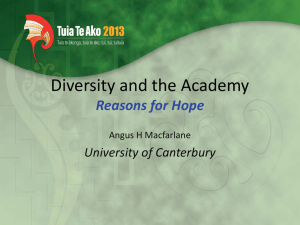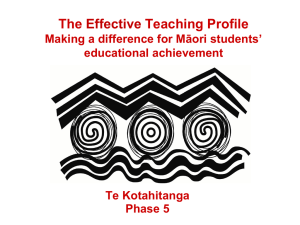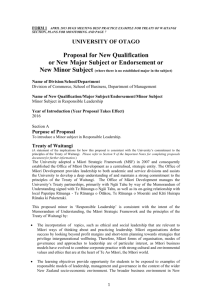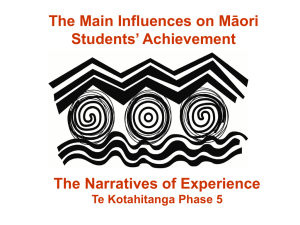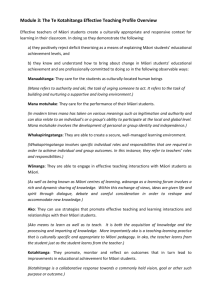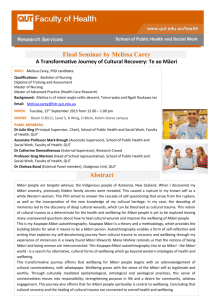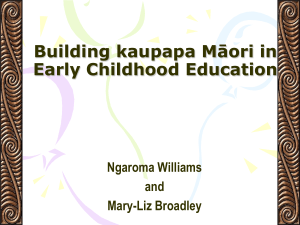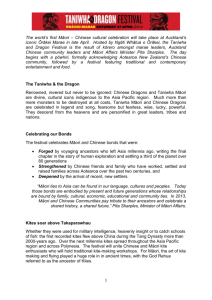here - New Zealand China Trade Association
advertisement
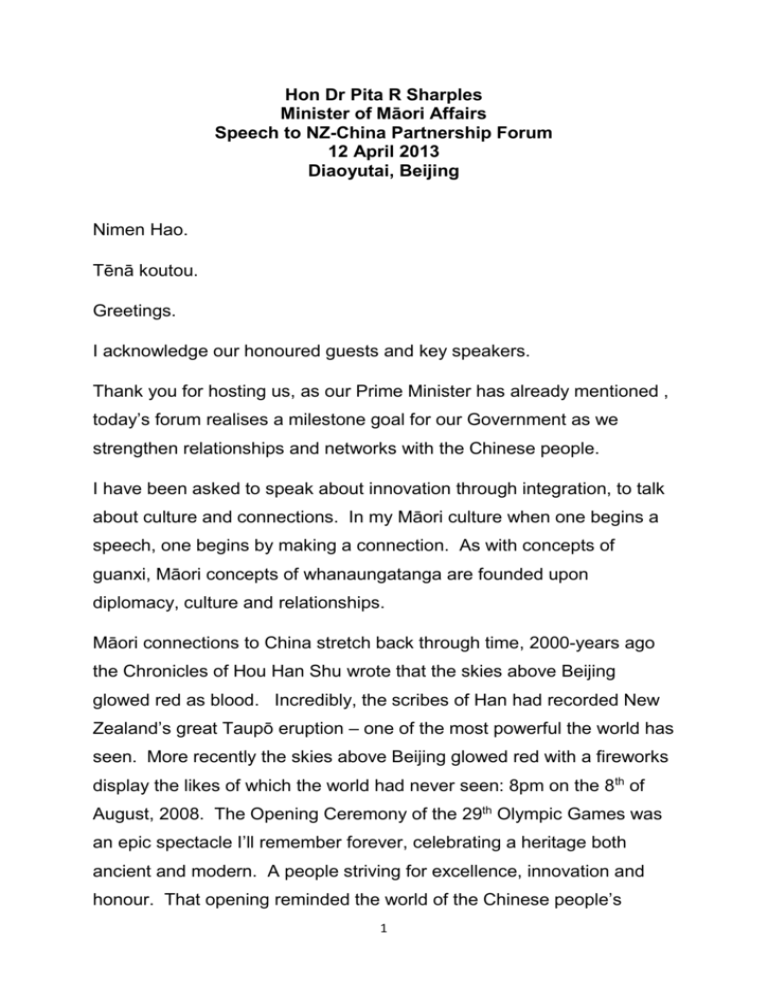
Hon Dr Pita R Sharples Minister of Māori Affairs Speech to NZ-China Partnership Forum 12 April 2013 Diaoyutai, Beijing Nimen Hao. Tēnā koutou. Greetings. I acknowledge our honoured guests and key speakers. Thank you for hosting us, as our Prime Minister has already mentioned , today’s forum realises a milestone goal for our Government as we strengthen relationships and networks with the Chinese people. I have been asked to speak about innovation through integration, to talk about culture and connections. In my Māori culture when one begins a speech, one begins by making a connection. As with concepts of guanxi, Māori concepts of whanaungatanga are founded upon diplomacy, culture and relationships. Māori connections to China stretch back through time, 2000-years ago the Chronicles of Hou Han Shu wrote that the skies above Beijing glowed red as blood. Incredibly, the scribes of Han had recorded New Zealand’s great Taupō eruption – one of the most powerful the world has seen. More recently the skies above Beijing glowed red with a fireworks display the likes of which the world had never seen: 8pm on the 8th of August, 2008. The Opening Ceremony of the 29th Olympic Games was an epic spectacle I’ll remember forever, celebrating a heritage both ancient and modern. A people striving for excellence, innovation and honour. That opening reminded the world of the Chinese people’s 1 phenomenal and ongoing contribution to global culture, economy and civilisation. And I am incredibly proud to say it is a civilisation, a heritage and a people that Māori are intrinsically linked to. Thousands of years ago our Polynesian ancestors set off from Asia. As they left, they looked to the stars, using astronavigation they guided entire communities across millions of square miles of ocean. Using advanced science they crafted the world’s first long range, open sea faring vessels. From Papua in the west, Hawaii in the north, Rapanui in the east and Aotearoa in the south: over 80 generations they discovered and settled a third of the surface of our planet. I proudly acknowledge our shared heritage and pay tribute to all of our ancestors and acknowledge their courage, audacity and genius. As we prepare for the future – we can find inspiration in our not too distant past. We can look to our ancestors from across the Asia Pacific region, the ultimate explorers, leaders, innovators of their time. So when Māori think of a long term investment we aren’t just thinking of ourselves here in 2013. We’re thinking of those who have gone before us and those yet to be born: upon our shoulders are huge responsibilities, we are but one generation within a family tree that stretches back through eternity. How far it will branch out into the future? That part’s up to us. Instead of only focusing on how much our assets are worth we need to ask ourselves: What can we turn them into? How can we future proof them for future generations? I’ve been proud to lead Māori trade missions to China where our generational way of thinking resonated with our hosts, because like us, the people of China are planning for the future while honouring the past. Within a few generations, China’s Dragon Economy has become our global 2 economy’s centre of gravity. Our Māori Dragon Economy – or as we call it our Taniwha Economy - can look to China, to Asia for inspiration. Right now Māori control around forty per cent of all fish quota in New Zealand; a third of all plantation forests; we own some of the country’s largest farms; our tribes control billions of dollars worth of assets. We know we must invest in science, innovation and education: this will determine the future of our Taniwha Economy as well as the future of our people. Our Māori businesses are working with communities across China. I am particularly proud of an agricultural exchange launched last year between the People’s Republic of China’s Government of Guizhou Province and my government department, Te Puni Kōkiri. We have developed a strong and close relationship with the people of Guizhou, a beautiful, unique province that is rich in cultural and natural resources with huge tourism and agricultural potential. We are investing in the future by investing in the education of students from Guizhou’s ethnic minorities as well as our own young Māori farmers. As well as ancient ties to China, Māori recognise more recent ties. We recognise that China isn’t merely a foreign export market thousands of miles away – Chinese people have lived alongside us for nearly 200years. Nearly a century ago the SS Ventnor ship sunk and the remains of 500-men – en route go Guangdong for burial – were also lost. This tragedy devastated their families who contemplated an eternity where their loved ones souls could never be at rest. But a few years ago those men’s descendents discovered their forebears hadn’t been lost at sea, but had been laid to rest in sacred, tribal burial grounds. They’d been cared for by the local Māori tribe whose members had recovered, prayed 3 over and buried these men alongside their own ancestors and loved ones. One week ago as part of Qingming (Ching Ming) 2013, Chinese and Māori descendents gathered on our remote beaches to unveil special memorials honouring their ancestors. After a very successful time at the National Museum of China, New Zealand’s exhibition of Jade treasures – Kura Pounamu – will soon head south to Guangdong: we are delighted that our Greenstone will be displayed in the ancestral lands of so many Chinese New Zealanders. An ancient treasure prized as much for its beauty as its sacred links to the Gods: few cultures share the same reverence for Yu or Pounamu as Chinese and Māori people. We both believe Jade has a heritage, a whakapapa linking us back to ancient times. We are also hugely grateful to the National Museum of China for displaying a treasured feather cloak that was gifted to Chairman Mao Zedong by our Māori King Korokī in 1957. Later this month I will be helping to host the Taniwha and Dragon Festival: the world’s first event bringing together Māori and Chinese communities to honour our cultural, historical and ongoing relationships. We chose a Chinese Dragon and Māori Taniwha as our symbols because like you we celebrate Dragons in legend and song, fearsome and fearless, wise, lucky, powerful. Great Dragons and Taniwha descend from the heavens and are personified in great leaders, tribes and nations. There is one other ancient bond we share with the people of China. Its English name is the Godwit bird. In China, I’m told it is Ban-wei ChengYu. Māori call it the Kūaka bird. For generations of ocean navigators: this bird was one of our many guides. Every year at the end of our 4 Summer, thousands of birds, gather at New Zealand’s most northern tip, we call Te Rerenga Wairua. For Māori it is a hugely sacred place, it is the departure point for souls, back to our ancestral homelands, in English it is called Spirits Bay. It is here and other sites that these birds gather in their thousands before taking flight, crossing the Pacific in a week and heading north to China: Stopping only when they reach Dandong, Liaoning Province. Their amazing flight between Te Reinga and the Yalu River is the longest non-stop flight of any bird on earth. Every year this tiny bird traces the journeys of our ancestors back across the Pacific, back to Asia, back thousands of miles and thousands of years. And in doing so, forever linking the peoples of New Zealand to the peoples of China. It is fitting that this very week as I stand to greet you: the Kūaka, the Ban-wei Cheng-Yu returns to China from New Zealand. We have a carving of this bird in our Parliament; I would like to leave you with the Māori proverb carved beneath it: Ko au te moemoea o te iwi: Te Tawhiti o tāku rere ka rite tonu ki te hohonu me te mārama o a koutou whakarite. I am the dreams of the people. The length of my flight depends on the wisdom of your decisions. 5


